I was an editor at large at POZ magazine from 2012 to 2020, reporting on thousands of studies about HIV published in journals or presented at conferences. Together with my reporting for POZ's sister publications, Hep and Cancer Health magazines, I estimate that I wrote nearly 2 million words during that eight-year period.
These are highlights from my tenure. For more detailed archives from the magazine, see the HIV page.
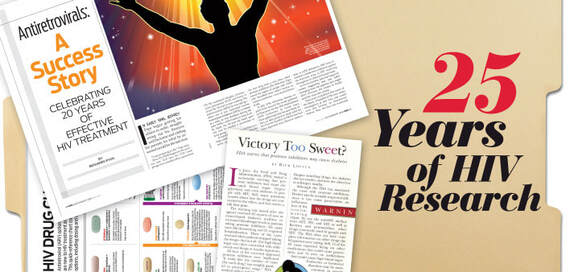
25 Years of HIV Research
POZ, July 2019
To mark POZ magazine's 25th anniversary: a review of the extra-ordinary achievements on the part of HIV scientists since 1994. The ever-refined collective mastery they have gained over the virus during this period represents one of the greatest achievements of human ingenuity.
POZ, July 2019
To mark POZ magazine's 25th anniversary: a review of the extra-ordinary achievements on the part of HIV scientists since 1994. The ever-refined collective mastery they have gained over the virus during this period represents one of the greatest achievements of human ingenuity.

The Road Ahead For HIV Cure Research
POZ, January 2019
Today, with better understanding of the complex task at hand, HIV cure researchers are investigating multiple avenues and taking the long view. Along the way, they hope to discover ways of making infection with the virus increasingly innocuous.
POZ, January 2019
Today, with better understanding of the complex task at hand, HIV cure researchers are investigating multiple avenues and taking the long view. Along the way, they hope to discover ways of making infection with the virus increasingly innocuous.

Generation PrEP?
POZ, April 2018
By and large, men who have sex with men who use Truavda as pre-exposure prophylaxis (PrEP) against HIV are white and over the age of 25. In light of recent HIV diagnosis trends, the lopsidedness of these PrEP uptake numbers reveals the troubling truth lurking behind all the recent fanfare about the HIV prevention method: It is failing to reach many of those who stand to benefit from it the most.
POZ, April 2018
By and large, men who have sex with men who use Truavda as pre-exposure prophylaxis (PrEP) against HIV are white and over the age of 25. In light of recent HIV diagnosis trends, the lopsidedness of these PrEP uptake numbers reveals the troubling truth lurking behind all the recent fanfare about the HIV prevention method: It is failing to reach many of those who stand to benefit from it the most.
Is Kenneth Cole Shifting Blame for the Harvey Weinstein Charity Controversy?
At stake in amfAR’s civil war is the nonprofit’s quest to find a cure for HIV.
At stake in amfAR’s civil war is the nonprofit’s quest to find a cure for HIV.

POZ magazine, Jan. 21, 2018
Investigative report
They bent the rules for Harvey Weinstein, and now they’re paying the price.
AmfAR, The Foundation for AIDS Research has long relied on the now-disgraced Hollywood mogul to supply celebrities, cachet and cash for its fundraising efforts. And now as the nonprofit faces a reckoning born from this dependence, the stakes are particularly high for its famous board chairman: the fashion magnate Kenneth Cole, who has carefully built his eponymous brand around his own image as a philanthropist.
Investigative report
They bent the rules for Harvey Weinstein, and now they’re paying the price.
AmfAR, The Foundation for AIDS Research has long relied on the now-disgraced Hollywood mogul to supply celebrities, cachet and cash for its fundraising efforts. And now as the nonprofit faces a reckoning born from this dependence, the stakes are particularly high for its famous board chairman: the fashion magnate Kenneth Cole, who has carefully built his eponymous brand around his own image as a philanthropist.

"Nevertheless They Persisted"
(POZ, September 2017)
In the face of potential budget cutbacks or continued flat funding, HIV scientists and advocates are waging a powerful war against the global epidemic. The 9th International AIDS Society Conference on HIV Science in Paris saw myriad reasons for hope but also considerable cause for concern about the future of the global fight.
(POZ, September 2017)
In the face of potential budget cutbacks or continued flat funding, HIV scientists and advocates are waging a powerful war against the global epidemic. The 9th International AIDS Society Conference on HIV Science in Paris saw myriad reasons for hope but also considerable cause for concern about the future of the global fight.

"HIV 2020"
(POZ, June 2017)
The dawning of the 2020s will bring HIV into its fifth decade. Crystal balls are by their nature hazy, and the current political climate raises many worrisome questions about how shifting federal priorities may affect people living with and at risk for HIV. Nevertheless, thanks to recent promising strides in HIV research and public health efforts to tackle the virus from all sides, leaders in the field are increasingly optimistic about what the next decade of the epidemic will look like.
(POZ, June 2017)
The dawning of the 2020s will bring HIV into its fifth decade. Crystal balls are by their nature hazy, and the current political climate raises many worrisome questions about how shifting federal priorities may affect people living with and at risk for HIV. Nevertheless, thanks to recent promising strides in HIV research and public health efforts to tackle the virus from all sides, leaders in the field are increasingly optimistic about what the next decade of the epidemic will look like.

"PrEP: A Dream Deferred."
(POZ, January 2017)
Truvada as pre-exposure prophylaxis (PrEP) is failing the demographic that needs it most, black men who have sex with men (MSM). Meanwhile, Truvada’s increasing popularity as HIV prevention among white MSM means PrEP is apparently on a path to widen already tragic racial disparities in infection rates among MSM.
Are those who launched PrEP to blame for failing to anticipate its anemic uptake among black MSM?
(POZ, January 2017)
Truvada as pre-exposure prophylaxis (PrEP) is failing the demographic that needs it most, black men who have sex with men (MSM). Meanwhile, Truvada’s increasing popularity as HIV prevention among white MSM means PrEP is apparently on a path to widen already tragic racial disparities in infection rates among MSM.
Are those who launched PrEP to blame for failing to anticipate its anemic uptake among black MSM?

"Antiretrovirals: A Success Story." (POZ, June 2016)
Celebrating 20 years of effective HIV treatment
In July 1996, infectious disease experts gathered in Vancouver for the 11th International AIDS Conf-erence. These gatherings had become bleak affairs in recent years, as data painted in stark relief the fact that the handful of drugs approved since AZT in 1987 had proved a feeble line of defense against HIV. But data had recently begun to surface suggesting that emerging drugs might allow clinicians the means to finally send the virus into retreat.
Celebrating 20 years of effective HIV treatment
In July 1996, infectious disease experts gathered in Vancouver for the 11th International AIDS Conf-erence. These gatherings had become bleak affairs in recent years, as data painted in stark relief the fact that the handful of drugs approved since AZT in 1987 had proved a feeble line of defense against HIV. But data had recently begun to surface suggesting that emerging drugs might allow clinicians the means to finally send the virus into retreat.

"A Tale of Two Cities."
(POZ, May 2016)
New York City and San Francisco want to end their HIV epidemics.
San Francisco recently launched a multipronged HIV-fighting campaign called “Getting to Zero,” in which the members of local academia, the public health department and community-based organizations, as well as government officials and health care providers, are working in lockstep. Meanwhile, the major players in New York’s epidemic have formed a similar alliance.
(POZ, May 2016)
New York City and San Francisco want to end their HIV epidemics.
San Francisco recently launched a multipronged HIV-fighting campaign called “Getting to Zero,” in which the members of local academia, the public health department and community-based organizations, as well as government officials and health care providers, are working in lockstep. Meanwhile, the major players in New York’s epidemic have formed a similar alliance.
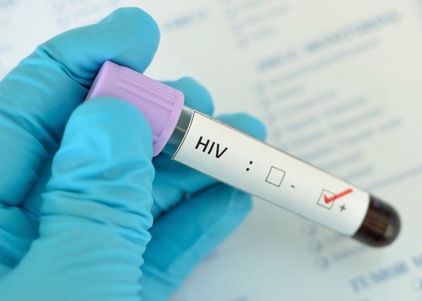
"PrEP Fails in Gay Man Adhering to Daily Truvada, He Contracts Drug-Resistant HIV."
(POZ, February 2016)
Researchers have for the first time documented a case of an individual contracting HIV, a multi-drug resistant strain, while apparently adhering well to the daily regimen of Truvada (tenofovir/emtricitabine) as pre-exposure prophylaxis (PrEP). The scientists concluded that it is indeed possible for individuals who are adherent to PrEP to contract HIV when they are exposed to a virus that is resistant to both drugs included in Truvada. While this case is concerning, experts in the PrEP field suggest that such failures of PrEP will likely remain rare.
(POZ, February 2016)
Researchers have for the first time documented a case of an individual contracting HIV, a multi-drug resistant strain, while apparently adhering well to the daily regimen of Truvada (tenofovir/emtricitabine) as pre-exposure prophylaxis (PrEP). The scientists concluded that it is indeed possible for individuals who are adherent to PrEP to contract HIV when they are exposed to a virus that is resistant to both drugs included in Truvada. While this case is concerning, experts in the PrEP field suggest that such failures of PrEP will likely remain rare.
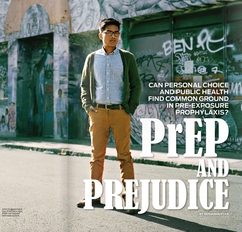
Sept. 2015: For my coverage of Truvada as pre-exposure prophylaxis (PrEP) against HIV, I received the Excellence in HIV/AIDS Coverage Award from NJLGA, the Association of LGBT Journalists, as well as a bronze award for health information reporting from the National Health Information Awards. The article, "PrEP and Prejudice", which appeared in POZ magainze's Oct/Nov 2014 issue, examines the science surrounding the new HIV prevention method (taking a pill each day reduces risk by over 99 percent) while asking tough questions about whether PrEP will ultimately reduce HIV incidence among gay and bisexual men.
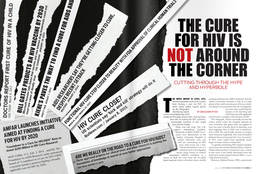
"The Cure For HIV Is Not Around the Corner." (POZ, Oct. 2015) Cutting through the hope and the hyperbole.
Erroneous media reports aren't the only cause of the public's misperception that a cure for HIV is "within reach." Even non-profit leaders such as amfAR and Bill Gates have contributed, willfully or not, to this gross distortion of the truth. This article seeks to set the record straight and give readers and accurate sense of where we are in the quest for a cure.
Erroneous media reports aren't the only cause of the public's misperception that a cure for HIV is "within reach." Even non-profit leaders such as amfAR and Bill Gates have contributed, willfully or not, to this gross distortion of the truth. This article seeks to set the record straight and give readers and accurate sense of where we are in the quest for a cure.
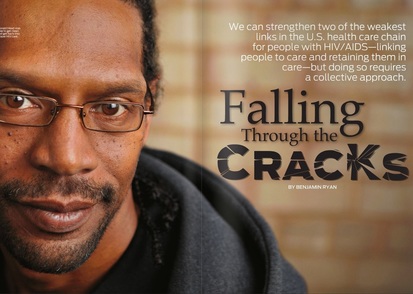
“Falling Through the Cracks.”
(POZ, March 2013)
We can strengthen two of the weakest links in the U.S. health care chain for people with HIV/AIDS: linking people to care and re-taining them in care. Doing so requires a collective approach. In the meantime, only an estimated 16 to 36 percent of Americans with HIV have a suppressed viral load. This figure is the last calculation in a series of statistical wake-up calls that have shaken the HIV community since the 2010 introduction of a a new catchphrase: the “treatment cascade.”
(POZ, March 2013)
We can strengthen two of the weakest links in the U.S. health care chain for people with HIV/AIDS: linking people to care and re-taining them in care. Doing so requires a collective approach. In the meantime, only an estimated 16 to 36 percent of Americans with HIV have a suppressed viral load. This figure is the last calculation in a series of statistical wake-up calls that have shaken the HIV community since the 2010 introduction of a a new catchphrase: the “treatment cascade.”